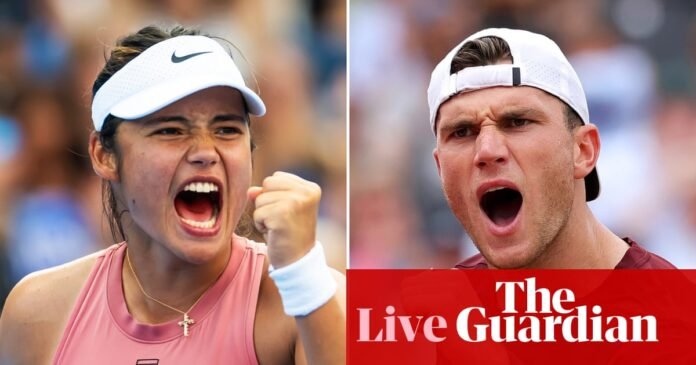Key events
First up, Fritz/Rybakina are down 30-40, the former serving. But Vavassori nets with plenty of court at which to aim, meaning a deciding point … settled by a booming Fritz forehand. I do not think this’ll be the last time I type those words or variations of them over the next fortnight. Meantime on Ashe, Monfils holds, so he and Osaka lead McNally/Musetti 1-0.
Righto, I’ve found Errani/Vavassori v Rybakina/Fritz. Obviously I’m impartial, but come on the champs.
Our first two pairs are out on Ashe; I’m not yet certain if we can watch Armstrong too.
The rules
The last 16, quarter-finals and semi-finals will be best of three sets, but first to four games not six. If a game goes to deuce, the winners of the next point take it – there’s no advantage. If a match is level at a set apiece, a 10-point match tiebreak will settle it.
Breaking: Danielle Collins and Christian Harris replace Sinner/Siniakova.
On which point, the reason for the TBD below is that Jannik Sinner, who retired ill when 5-0 down to Carlos Alcaraz in the Cincinnati final, has pulled out.
I can’t lie, I’m buzzing that we’ve got two extra days of banging tennis. This competition should just feature the best mixed doubles pairings, not the best singles players who can be arsed.
Email! “I agree, its money-fuelled tokenism and could cause the end of doubles as we know it at the major tournaments, says Andrew Benton. “Or, it might be the start of a doubles revival, from which the specialists will benefit particularly – at least people will be watching these matches as they feature the rich and famous, and who knows where that extra interest and investment could lead. Well, probably nowhere. But it’s a bit like the Hundred.”
I disagree it’s like the Hundred as that isn’t taking a major tournament away from those who play the event best. I also don’t believe doubles needs gimmicks – it just needs to be marketed and respected properly. Henry Patten was really good on this when I interviewed him in May.
The winners – we’ll know who they are tomorrow – will earn $1m, fives times more than went to last year’s champions. According to BBC, appearance fees are north of $50,000, or in other words, the players involved are competing to get paid and to prepare for their singles campaigns, not because they’re motivated to win a grand slam.
I’ve not the slightest clue how the seeding works, but it’s worth noting that Errani/Vavassori, included as a sop to sporting merit – they’re the defending champions – have not been so honoured.
Order of play
Ashe
Naomi Osaka/Gaël Monfils v Caty McNally/Lorenzo Musetti (4pm BST)
Iga Swiatek/Casper Ruud (3) v Madison Keys/Francis Tiafoe (not before 5pm BST)
Winners meet in quarter-final
Jessica Pegula/Jack Draper (1) v Emma Raducanu/Carlos Alcaraz (not before 7pm BST)
Olga Danilovic/Novak Djokovic v Mirra Andreeva/Daniil Medvedev
Winners meet in quarter-final
**
Armstrong
Sara Errani/Andrea Vavassori v Elena Rybakina/Taylor Fritz (2)
Venus Williams/Reilly Opelka v Karolina Muchová v Andrey Rublev
Winners meet in quarter-final
Taylor Townsend/Ben Shelton v Amanda Anisimova/Holger Rune (not before 5.30pm BST)
TBD v Belinda Bencic/Alexander Zverev
Winners meet in quarter-final
Preamble
We’re all friends here so we can be honest with each other: I’m not exactly at one with what we’re about to enjoy.
Why? Because doubles tennis is a specific skill, nurtured and developed by players relying on it – and a system that’s operated for decades – to make a living. So confiscating a huge competition from them, to hand money to suits and superstars – who do not need it and are, individually and as pairs, less good at the actual sport – doesn’t sit right with me.
On the other hand and just as they want us to say, take a look at that lineup! Such is sport, such is the world, such is life; let’s make the best of it, I guess.





